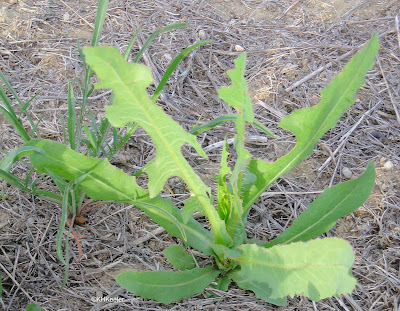 |
| wild lettuce, probably prickly lettuce, Lactuca serriola |
They are native all over the world: North America, Mexico, Central America, Eurasia, Africa.
 |
| Young wild lettuce, prickly lettuce, Lactuca serriola |
The milky sap of lettuces contains a potent sesqueterpine lactone, called lactucin. Lactucin has analgesic and sedative properties. Lettuce sap, "lettuce opium," also called lactucarium, was used to induce sleep and calm patients from at least Roman times. In the 19th century it became quite popular because, unlike opium, it is not addictive. Then a series of 20th centuries studies showed that popular formulas had no effect, and it was abruptly dropped by the medical community. However, recent studies agree that lactucarium does have analgesic and sedative properties, the problems for using it seem to be in details of preparation and preservation. Twentieth and 21st century herbal medicine sources use the wild European lettuces, prickly lettuce (L. serriola) and wood lettuce, also known as sleepwort (L. virosa) to obtain lactucarium. In the historic literature, it sounds like garden lettuce had sedative properties and was used as a medicine. There is some lactucin in modern garden lettuce--romaines have the most--but not much. Maybe it was bred out to make the leaves less bitter, maybe garden lettuces were selected for pretty leaves and lost lactucin accidentally. For the historical literature quoting garden lettuce as a medicine, I can't tell whether ancient garden lettuce was more potent or whether the writers didn't distinguish between bitter or prickly lettuce and garden lettuce.
Native Americans used native American wild lettuces in the same ways Europeans used European wild lettuces, as analgesics and sedatives and to ease lactation. They also used it to treat diarrhea. The Iroquois put mashed roots on a severely bleeding cut. The Menominee rubbed the juice on blisters from poison ivy. Many tribes ate the leaves. When the European wild lettuces reached them, Native Americans used those too.
 |
| Prickly lettuce, flowers, seeds, Note green caterpillar, right above the "c" in lettuce. above. |
 |
| very tall prickly lettuce |
Most wild lettuces are annuals or biennials (flower the second year, then die), although prickly lettuce is perennial. Often they start as a rosette (circle) of leaves close to the ground and then send up a mostly leafless tall flowering stalk.The wild lettuces put down a tap root (making them relatively easy to weed out of your garden). The leaves of prickly lettuce are variable in shape and can be deeply scalloped. Often the leaves are positioned at right angles to the ground, presumably to reduce the heat-load. The flowers appear in mid-summer and continue into late summer. In most species they are yellow and about 1/4 inch in diameter, opening when the sun is bright and warm, closing in cooler days and at night, very like the behavior of dandelion (Taraxacum officinale) flowers, to which they are rather closely related. Also like dandelions, the mature seeds are attached to a white pappus that allows them to catch the wind and float away.
There is not a lot of easily available information on uses of native wild lettuces by native insects, though as widespread natives, undoubtedly they food for a number of native insects. The flowers are attractive to bees; among native bees, especially leaf-cutter bees, genus Megachile, and halictids, genus Lasioglossum. Caterpillars of the common looper moth (Autrographa precationis), virgin tiger moth (Grammia virgo) and intermediate cuculia (Cuculia intermedia) feed on wild (and cultivated) lettuces. Wild lettuces are also eaten by aphids, which attract aphid predators such as ladybugs. And, grasshoppers--excellent bird food--will devour even prickly lettuce:
 |
| prickly lettuce decorated by grasshoppers eating it; |
Comments and corrections welcome.
References
Angiosperm Phylogeny Working Group. 2023. Asteraceae. Chicoridae. link (Accessed 4/21/23)
Culpeper, N. 1880. Culpeper's Complete Herbal. Originally 1652. Foulsham Press, London. There are dozens of editions of Culpeper from the last 350 years, as facsimilies on Open Library. Most list only Lactuca sativa as lettuce. The edition I have has both L. sativa and great wild lettuce, Lactuca virosa. He considers great wild lettuce an excellent medicine. Here is the link to the edition I have. link p. 213.
Lactuca L. Plants of the World Online. Royal Botanic Gardens Kew. link (Accessed 4/21/23)
Moerman, D. E. 1998. Native American Ethnobotany. Timber Press. Portland, OR.
Pollington, S. 2000. Leechcraft. Early English Charms, Plantlore and Healing. Anglo-Saxon Books. Norfolk England.
Strother, J. L. 2020. Lactuca Linnaeus Floral of North America link (Accessed 4/21/23)
Stubbendieck, J., M. J. Coffin and L. M. Landholt. 2003. Weeds of the Great Plains. Nebraska Department of Agriculture. Lincoln, NE.
Wild lettuce. Lactuca canadensis. Aster Family (Asteraceae). Illinois Wild Flowers. link (Accessed 4/22/23).
No comments:
Post a Comment